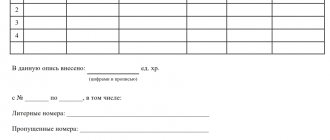VKontakte
When concluding a rental agreement for residential premises, each party reasonably wants to protect their interests and insure themselves in case of conflict.
A time-tested principle says: the more detailed the contract is, the fewer problems will arise during its execution. Therefore, a correctly compiled inventory of property is your faithful assistant when renting or renting an apartment.
Concept
An inventory of property refers to the process of listing items located on the territory of the premises being rented out and having material value, as well as the document itself, which is obtained as a result of such listing.
The main purpose of drawing up an inventory is to minimize the risk of disagreements between the tenant and the owner.
The completed inventory will be useful for both parties:
- the owner of the property, using an inventory, ensures the safety of the transferred property, and in the event of its damage or disappearance, receives evidence for compensation of losses;
- the tenant, in turn, as a result of drawing up such a document, insures himself against the fulfillment of unreasonable demands for the return or payment of what was not in the apartment at the time of delivery.
The document can be drawn up at the initiative of any party to the contract, the main thing is that the information entered corresponds to reality.
It is advisable to use one of the following options:
- The owner invites the future tenant to the apartment, and a list of transferred property is drawn up in his presence. This will help avoid disagreements regarding the availability, quantity and quality characteristics of the transferred property.
- The owner draws up the inventory individually, and when transferring the apartment for use, all described property is checked by the tenant for availability and condition. This option allows the tenant to save time.
✒️ How to properly make an inventory of property
An inventory of property is drawn up in written or printed form or on a printed form in two copies. If an agent is involved in the transaction process as an intermediary, a third copy will be required.
The inventory may be a separate document or part of the lease agreement.
It should contain the following data:
- Full name of the parties to the transaction;
- their passport details;
- permanent registration address;
- a list of property objects transferred for temporary use to the tenant;
- date and place of document preparation;
- signatures of the parties with transcripts.
At the request of the owner, an additional inventory can be drawn up of items that are prohibited from being removed from the apartment, as well as property that cannot be used.
The lessor has the right to indicate in the document the cost of the items being transferred.
The inventory is drawn up by the owner of the property in the presence of the tenant . The latter has the right to make additions to the document. When compiling an inventory, all detected defects, scratches and damage are listed. Household appliances must be checked for serviceability.
Mikhail Suvorov
Leading lawyer of the Legal.Center portal. Experience – 26 years
Ask a Question
Two acts of acceptance and transfer should be attached to the inventory, one of which is signed by both parties when new residents move into the rented apartment, and the second - when they evict.
Automatic extension of subsidies for housing and communal services
Look
Types of payments for children if the family income is less than the subsistence level
Look
How to enter data when hiring?
The result of the transfer of transferred material assets when renting out an apartment is an act. It is a table describing the transferred items.
Before the table you need to indicate the address and characteristics of the apartment:
- room area;
- separation or adjacency of rooms;
- the presence of a loggia or balcony;
- the condition of the walls, floor and ceiling, finishing materials (for example, a suspended ceiling or a floor covered with parquet, as well as tiles on the wall should be reflected in the inventory);
- condition of the entrance and the presence of interior doors;
- other indicators that you consider important.
Let's move on to filling out the table:
- Name of property - pay attention to the correct indication of the name of the property to protect yourself from disagreements in the future.
- Quantity - usually in pieces. For single large items such as a sofa, it is not particularly important and is a purely formal indicator, but it will not hurt if you decide to record the number of silver teaspoons in the kitchen cabinet.
- Condition – excellent, good, satisfactory. The parameter is often subjective, but important for assessment.
Note: the tabular form is not strictly necessary and is used only for ease of use.
If it is more convenient for you to sketch out a list or create an inventory in the form of continuous text, it will also be valid. Therefore, the choice is yours.
What form should I use for the inventory of transferred documents for the archive?
Every organization and every entrepreneur accumulates a lot of documents justifying certain business transactions, personnel movements, as well as other actions taken in the course of work activities.
The retention periods required for storing such documents vary greatly. “Basic storage periods for documents in an organization (archive)” will help you determine the necessary deadlines .
Meanwhile, compliance with such deadlines is mandatory, and because of this, documents cannot be disposed of earlier than the stipulated storage time. Therefore, a large number of papers are periodically sent to the archive. At the same time, some companies resort to the services of specialized archival organizations. When transferring documents to the archive, an inventory must be drawn up.
In practice, situations arise when it is necessary to bring up this or that documentation of past periods, again turning to the archive. An inventory of documents will help you quickly find the document you need.
The inventory of documents for the archive does not have a special format. Among its main details are:
- name of the organization (if the archive is a third-party organization);
- inventory number;
- date of inventory;
- name of documents deposited;
- the period to which the documents relate;
- document storage period;
- number of sheets;
- location of documents (number of folder, case or box);
- Full name and signatures of the responsible persons (the originator and the person who accepted the documents).
A sample list of documents for transfer to the archive can be downloaded from our website.
The inventory is also filled out when submitting sick leaves for payment to the Social Insurance Fund. Find out how to fill out a list of submitted applications and documents required for the assignment and payment of temporary disability benefits in ConsultantPlus. Study the material by getting trial access to the K+ system for free.
How to draw up a condition for an inventory?
There are a few details worth paying attention to:
- In the rental agreement, include a clause stating that the property is transferred according to the inventory, which is an integral part of the agreement. This way you legally link the two documents into a single whole.
- In the inventory act itself, enter information that it is an annex to the rental agreement for residential premises (if your agreement is called that way) under such and such a number from such and such a date. This information should be written down either in the upper right corner of the document above the title, or immediately below the title of the act.
- If there is little property to be transferred, you do not need to draw up a separate document, but enter the list directly into the contract. Legally there is no difference, it is purely a matter of convenience.
Attention! If you decide to limit yourself to entering a list of valuables into the contract without drawing up a separate document, you should use the wording: “The specified property was transferred to the tenant before signing the contract, in connection with which the parties agreed to consider this clause at the same time an act of acceptance and transfer.”
However, more often the inventory is drawn up as an appendix to the contract, since with a detailed description of the transferred values it turns out to be quite voluminous.
In addition, the inventory can reflect the fact of the transfer of property (to the tenant when concluding the contract, and back to the owner when leaving), then this document will combine the functions of the inventory and the transfer and acceptance certificate.
Regardless of which option you choose, pay attention to the fact that the fact of transfer of property is recorded in one way or another.
How to fill out the application?
You can use the documents presented here:
If cases are transferred to the archive
This inventory contains more mandatory fields than the one presented above. Compiled even if only one case is archived.
Read more: Rules for archival records management
If the transferred papers are not stored indefinitely, an additional column called “Storage period” is included in the table. In accordance with the “Basic Rules for the Operation of Organizational Archives” (approved by the decision of the Board of Rosarkhiv dated 02/06/2002), urgent storage is the maintenance of objects in the archive for up to 10 years. In addition, take into account the requirements of Order of the Ministry of Culture of Russia dated March 31, 2015 No. 526.
In the column “Deadline dates” the expiration dates for storage are indicated, both for securities subject to indefinite storage and for urgent ones. It is filled out on the basis of regulations. If necessary, the column “Date of document” is added, and this does not mean the date of preparation, but the day of registration.
If files are archived electronically, an inventory will also be required. Registration takes place with a note about their volume. This parameter is measured in megabytes.
Nuances of the procedure for renting out residential premises
When compiling a list of property, it is worth considering the following:
- The document, like the contract, is drawn up in 2 copies, one for each party. If the apartment was found through a realtor, then a third copy of both documents may be required.
- Make sure that the contents of all copies are absolutely identical, so as to subsequently protect yourself from finding out whose copy corresponds to reality.
- When describing the condition of each item, you need to take into account the possibility of its natural wear and tear. This is especially true for returning things to the owner when leaving the apartment. It is common for any thing to lose its new characteristics over time, and this must be taken into account. Normal wear and tear refers to those changes that a property undergoes during normal use during the lease term.
- When drawing up an inventory, you should immediately provide in the contract how events will develop in the event of damage or destruction of the described property by the tenant. Will he be obliged to pay the owner a fixed amount, or will compensation for damage be calculated based on the value of the damaged item? It is better to agree on all these points on the shore.
Example
Inventory of property
Appendix No. 1 to the “Apartment Rental Agreement” No. 23465 dated October 15, 2020
Signed in Moscow on October 20, 2021
We, Ilya Ivanovich Grigoriev, residing at the address: Moscow, Pushkina street, no. 10, apt. 41, below referred to as “Lessor”, on the one hand, and Egor Aleksandrovich Demidov, passport series 54 09, number 236875, issued 07/30/2007 Department of Internal Affairs for the Yaroslavl district of Moscow, below referred to as the “Tenant”, on the other hand, preserving the terminology of the specified Lease Agreement, with this Inventory we confirm the following:
- Simultaneously with the Premises, the Lessor transferred and the Tenant accepted for free use the following property located in the Premises:
- Furniture set “Victoria” - 6 items: bed (1 pc.), bedside table (2 pcs.), chest of drawers (1 pc.), wardrobe with a mirror door (1 pc.), chair (1 pc.), walnut color ", excellent condition, no defects.
- Bed linen - 3 sets, color: blue, white, green.
- Leather “Stella” chairs - 2 pcs., beige color, good condition, 2 scratches on the right side.
- Carpet — 1 piece, color green, good condition, small blue paint stain on one side.
- Gas stove "Electra" - 1 pc., model EK-65, serial number 123456, working condition, no defects.
- In case of loss or damage to property, the Tenant undertakes to pay compensation to the Lessor, depending on the amount of damage caused.
- The relations of the parties are determined by the specified Lease Agreement, the Inventory and the Civil Code of the Russian Federation.
- The inventory is compiled in 2 copies - one for each side.
Lessor: Grigoriev I.I.
Tenant: Demidov E.A.
Inspection algorithm
When inspecting an apartment, you should establish the availability and evaluate the quality of the property in as much detail as possible.
Step by step plan:
- Property located in the apartment - sofas, carpets, tables - assess the general condition and appearance.
- Electronics and household appliances - refrigerator, microwave, TV - check operation.
- Sockets and switches - inspect for serviceability.
- Plumbing - check the work and appearance, make a note in the inventory about possible leaks, chips of enamel, etc.
- Kitchen stove - turn on each burner, oven and evaluate performance.
- Dishes, small household items - check quantity and condition.
- Meters - carefully inspect the seals, make sure they are intact, record the meter readings.
Inventory principles
The inventory is either integrated into the text of the act itself, or is drawn up on a separate sheet, which will become an appendix to the act. The contents of the inventory should include:
- location of the property being described;
- the name of each piece of property indicating its generic name - sofa, table, wardrobe, TV, etc. If the unit is a set, then the number of similar items included in the set is indicated;
- make, model of property, year of manufacture, if it has these characteristics. It is allowed to indicate the value of individual items of property;
- the condition of each piece of property - new, used in working order, etc.;
- description of defects visible at the time of drawing up the inventory.
That is, descriptions must give the most accurate idea of the quantity and quality of the property being described. It is entirely acceptable to include in the act not only an inventory, but also photographs of the property being described.
List of criteria for describing existing items
- appearance;
- quantity;
- colors;
- defects: their presence, nature and severity;
- working or non-working condition;
- year of manufacture (for household appliances);
- brand of equipment;
- price.
Note: You have the right to indicate the price of the transferred items. In the event of damage, it will be easier to calculate its size and, accordingly, the amount of compensation.
But be reasonable: you should not indicate a deliberately disproportionate cost if you are the owner. And as a renter, pay attention that the owner of the apartment does not inflate the price of things that you will use.
Are there requirements for the form of the document?
The main requirement for an inventory is ease of use. The law does not limit either the content, structure, or method of creating such a document: it can be a table printed from a computer, or a list of items written by hand on a sheet of paper. The main thing is that the list contains the signatures of both parties.
Using an inventory is an effective way to regulate the relationship between the tenant and the apartment owner regarding the transferred property. It is worth spending the time and effort to compile it, and you will save yourself from possible problems.
If you find an error, please select a piece of text and press Ctrl+Enter.






![Bank Zenit mortgage and refinancing [credit][sale]](https://bgrielt.ru/wp-content/uploads/bank-zenit-ipoteka-i-refinansirovanie-credit-sale4-330x140.jpg)


